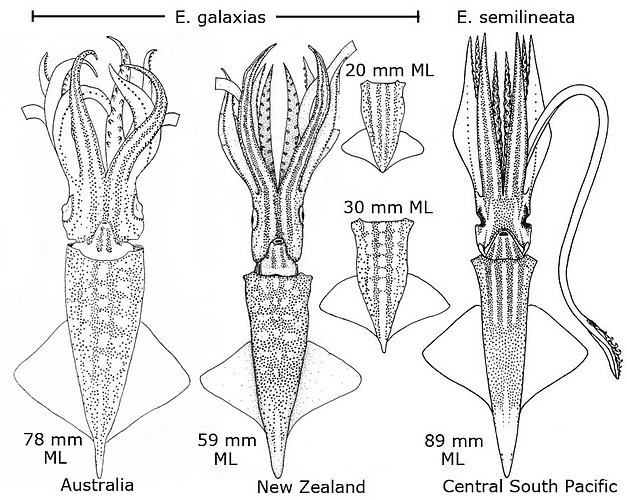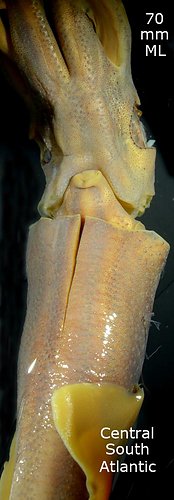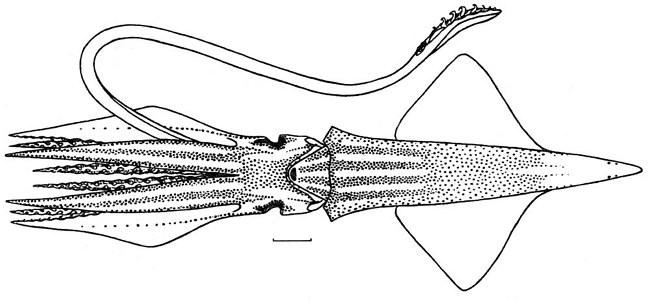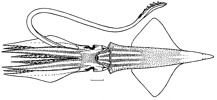Enoploteuthis semilineata
Kotaro TsuchiyaIntroduction
Enoploteuthis semilineata is known only from temperate South Pacific waters. This species closely resembles the North Pacific species E. chuni and the Australian-New Zealand species E. galaxias in the photophore arrangements.
Characteristics
- Tentacle
- Tentacle long, with distinct club.
- Carpal cluster oval.
- Two rows of different-sized hooks on manus.
- Four rows of suckers on dactylus.
- Hectocotylus
- Mature hectocotylus not described.
- Mature hectocotylus not described.
- Integumental Photophores
- Ventral mantle with four longitudinal stripes of integumental organs that become diffuse posteiorly.
- Ventral head with scattered integumental organs.
- Ventral side of arm III with a row of organs along almost entire length.
Comment
The above description is from Alexeyev (1994b).
Compare the following images:



Figure. Ventral views. Left - Composite drawing, from holotype and a paratype, from Berry (1918). Middle - Drawings from Riddell (1985). Right - Drawing from Alexeyev (1994b). Far right - Photograph of Enoploteuthis semilineata?, by R. Young.
Judging just from the illustrations, large E. galaxias and E. semilineata look very different. However the difference in photophore patterns is not as great as it first seems. Th mantle patterns of the two species probably began as 4 longitudinal series as seen in the 20 mm ML E. galaxias and the anterior mantle of E. semilineata. The spaces between the photophore series have filled in posteriorly in E. semilineata and partially throughout the mantle in E. galaxias but in a different manner, and with considerable inconsistency between the two E. galaxias illustrated.
E. semilineata from the South Pacific also differs greatly from E. semilineata? from the South Atlantic. In the latter the photophore arrangement on the head is like that of E. galaxias while that of E. semilineata is a solid block of photophores. In E. semilineata?, the mantle photophore series appears to extend the full mantle length as in young E. galaxias. Again adding photophores in some of the spaces between photophore series on the head and mantle of E. semilineata with growth, would eliminate these differences. Note, also, that in the drawing of E. galaxias from Australia, there are scattered photophores between the head series and it would not take too many more to make it look like E. semilineata.
If we were examining species of Abraliopsis rather than Enoploteuthis, there would be no doubt that we were dealing with three distinct species. However, with Enoploteuthis spp. we have little understanding of variability of photophore patterns between species and especially how this can be expressed during growth.
The three forms discussed here occupy a latitudinal belt roughly between 35-40°S from Australia eastward to Africa. In this region it is not unusual for a single species of squid to span this longitudinal range (e.g., Teuthowenia pellicuida: Voss, 1985; Histioteuthis atlantica: Voss, et al., 1998). The problem is: Are we dealing with three species of Enoploteuthis or one highly variable species?
Distribution
Geographical distribution
Type locality: 40°10,7'S, 127°48.4'W (ZMMSU No. U-386). This species is known only from the mixed waters of subantarctic frontal zone in central southern Pacific (Alexeyev, 1994a).References
Alexeyev, D.O. 1994a. New data on the distribution and biology of squids from the southern Pacific. Ruthenica, 4:151-166.
Alexeyev, D.O. 1994b. Enoploteuthis (Paraenoploteuthis) semilineata, a new species of squid (Cephalopoda, Oegopsida, Enoploteuthidae) from the southern Pacific. Ruthenica, 4:167-171.
Riddell, D.J. 1985. The Enoploteuthidae (Cephalopoda: Oegopsida) of the New Zealand region. Fisheries Research Bulletin (NZ), 27:1-52.
Voss, N. A. 1985. Systematics, biology and biogeography of the cranchiid cephalopod genus Teuthowenia (Oegopsida). Bull. Mar. Sci. 36: 1-85.
Voss, N.A., K. N. Nesis, P. G. Rodhouse. 1998. The cephalopod family Histioteuthidae (Oegopsida): Systematics, biology, and biogeography. Smithson. Contr. Zool., 586(2): 293-372.
About This Page

Tokyo University of Fisheries, Tokyo, Japan
Page copyright © 2015
All Rights Reserved.
- Content changed 21 January 2014
Citing this page:
Tsuchiya, Kotaro. 2014. Enoploteuthis semilineata . Version 21 January 2014 (under construction). http://tolweb.org/Enoploteuthis_semilineata/19714/2014.01.21 in The Tree of Life Web Project, http://tolweb.org/









 Go to quick links
Go to quick search
Go to navigation for this section of the ToL site
Go to detailed links for the ToL site
Go to quick links
Go to quick search
Go to navigation for this section of the ToL site
Go to detailed links for the ToL site